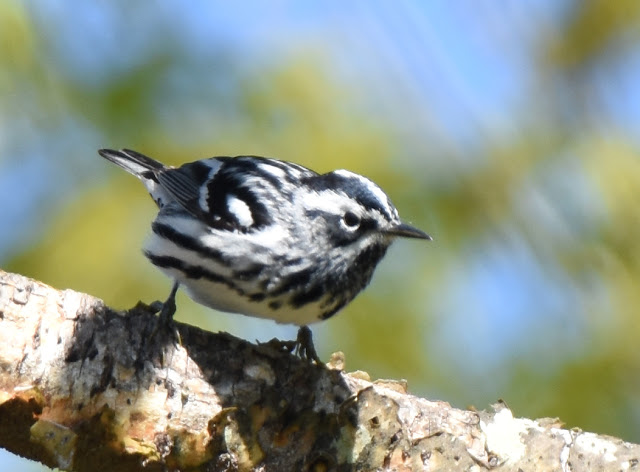Wind, weather, and driving instinct finally funneled migrating warblers to Halibut Point last Friday.
 |
Black-throated Blue Warbler |
Their arrival was also precisely timed to the hatching of caterpillars in the oak trees, which in turn were emerging just as buds were opening into luscious new leaves.
 |
The Warbler Tree |
Among all the oaks at Halibut Point, on this day, The Warbler Tree seemed to attract the most birds, with favorable over-the-shoulder sunlight and open sight lines for the photographer. All the following species visited the tree on Friday morning.
 |
Yellow Warbler |
High up in the canopy warblers darted about refueling after a strenuous night of migration flight. They navigated here unerringly in the protective dark.
 |
Black-and White Warbler |
Most of the birds foraged in the oak tree among emergent leaves and flowers. One exception was the Black-and-White Warbler which raced along bark surfaces hunting for insects as though schooled by nuthatches.
 |
American Redstart |
The flightiest of all the warblers was the Redstart. It regularly fanned its tail feathers, attempting to startle then snatch bugs from the branches.
 |
Black-throated Green Warbler |
As a group the warblers brought a brief tropical flair to Halibut Point. They looked more like equatorial birds summering north than temperate latitude birds wintering south.
 |
Northern Parula |
Given favorable winds, most of the warblers seem to stay only a day as they disperse to their up-continent breeding grounds, raise their young, and hurry back to warm climates in the fall.
 |
Cape May Warbler |
Every step of the way is keyed to an intricate chain of food sources becoming available on the journey.
 |
Magnolia Warbler |
The warbler clan, on the other hand, feeds a banquet of delight to naturalists. The anticipation of their appearance anchors the annual Birdathon that raises funds for Mass Audubon with friendly contestants vying for the greatest number of sightings in 24 hours.
 |
Host to migration |
Each of these feathered bundles of astonishment averages less than half an ounce in weight. The Warbler Tree lends its gargantuan growth cycle to sustain their moment of need. The migrants devour most of the insect larvae that are intent on devouring the tree leaves. A portion of everything survives to perpetuate the generations.
Another amazing chapter in this unending story!
ReplyDeleteAs much as I wish I could have been there to witness the warblers’ rest stop at the Warbler Tree, I had to stop my moment of wishing to say a gratitude prayer that Martin Ray was there to capture and convey it all to us. What a story!
ReplyDeletejust wow!!!
ReplyDelete👍
ReplyDeleteBeautiful, thank-you,
ReplyDeleteMartin.
Great photos. Seems that it is "over," but it was good while it lasted!
ReplyDeleteMartin! Gorgeous photos & your narration made me feel I was there. Had no idea about warblers & oaks... Lotta missed opportunities....Gracias, as always!
ReplyDelete